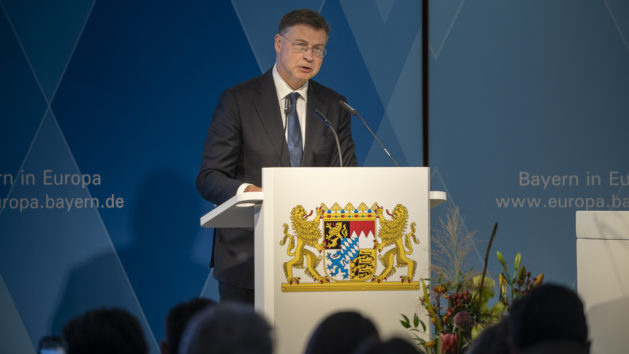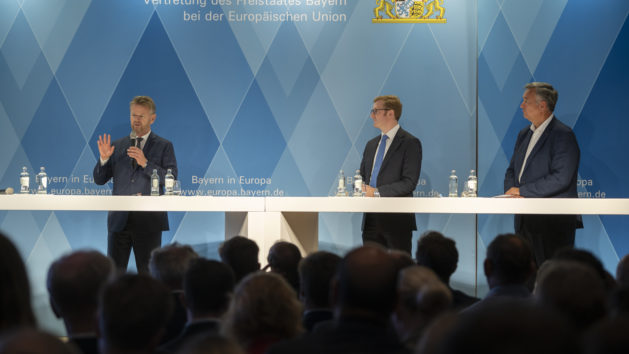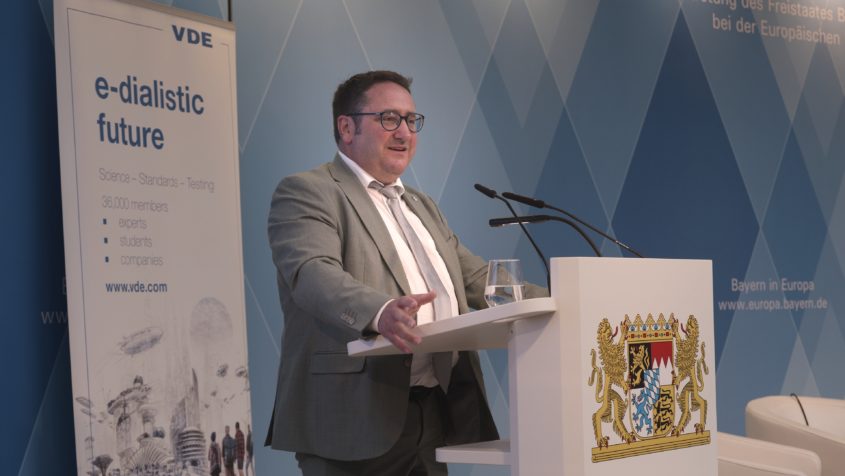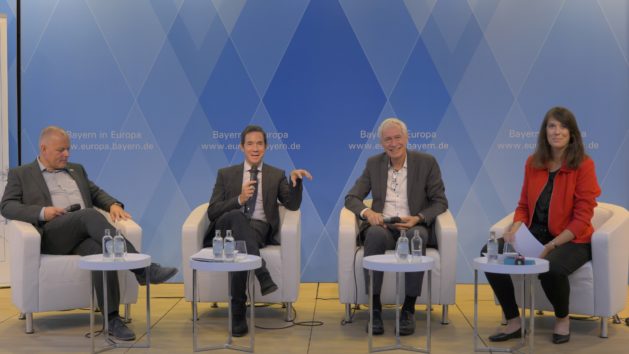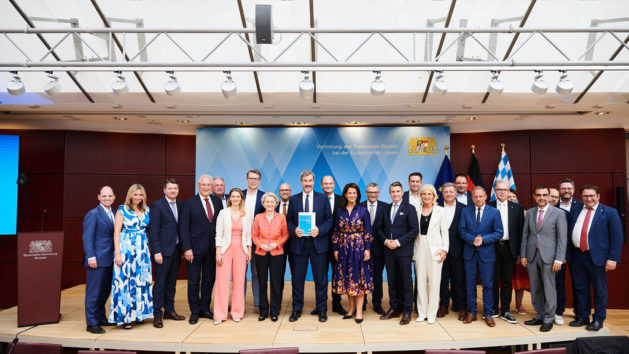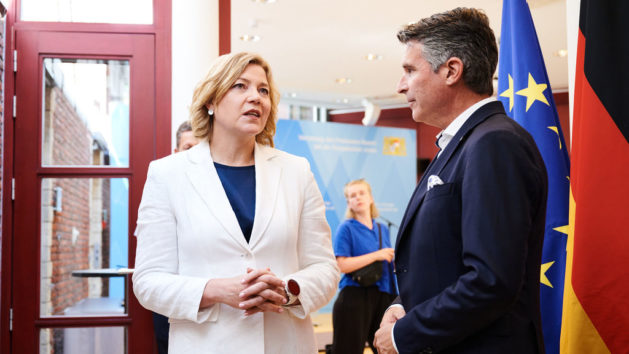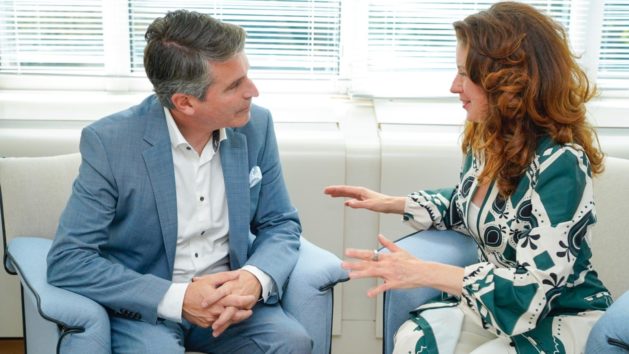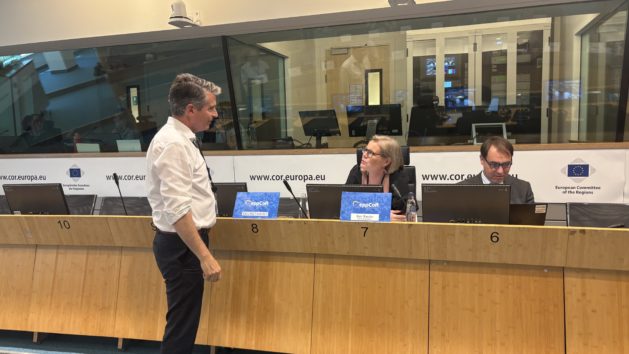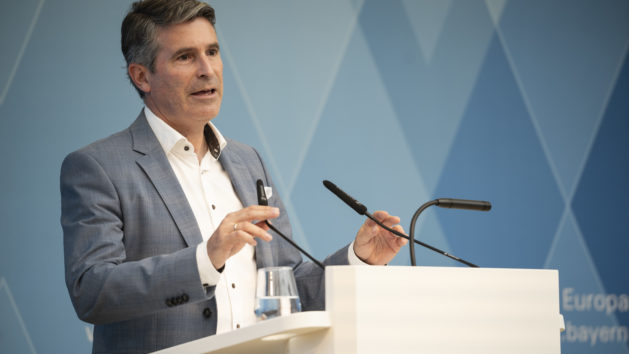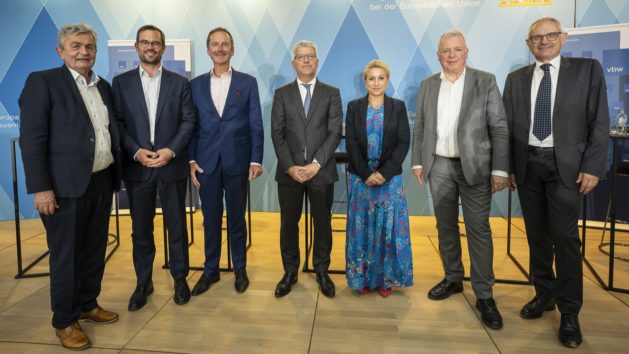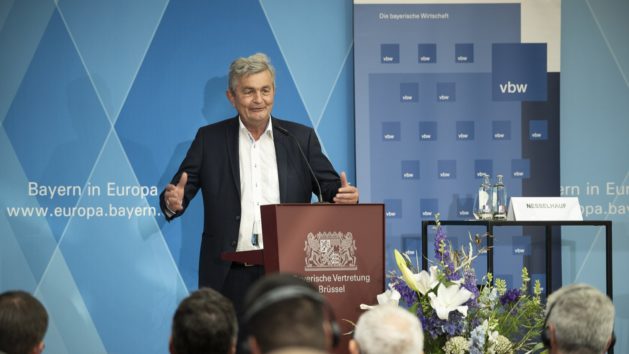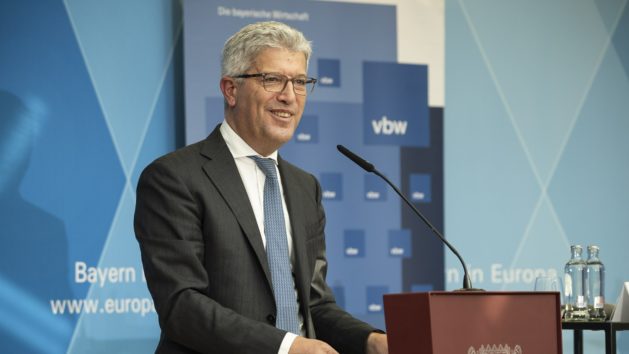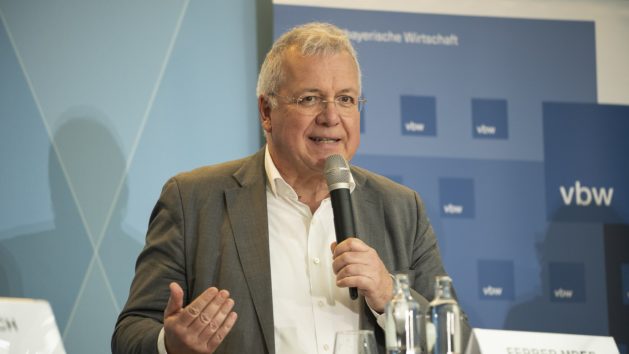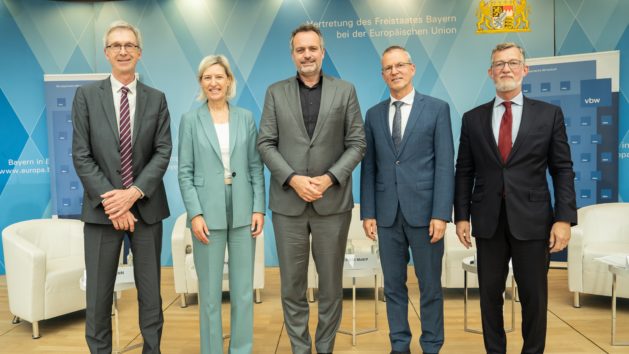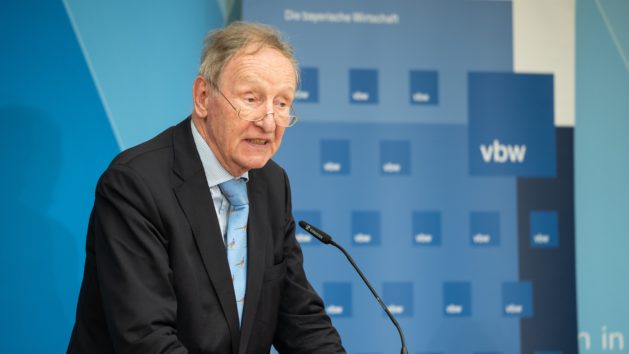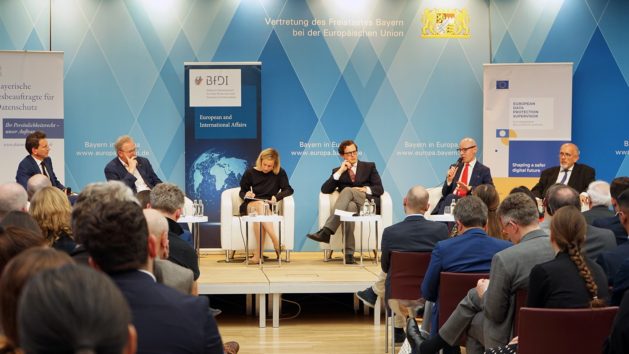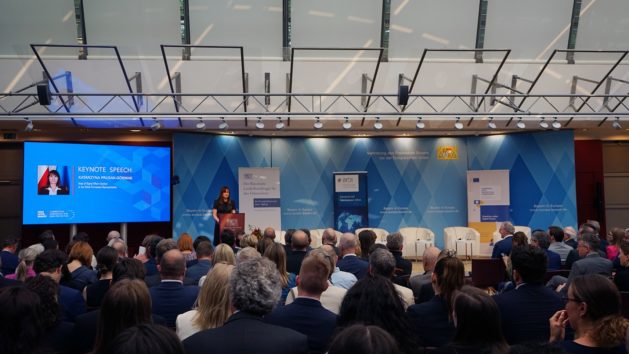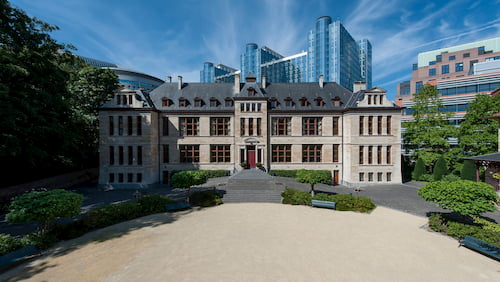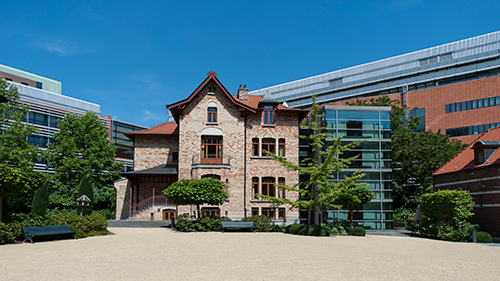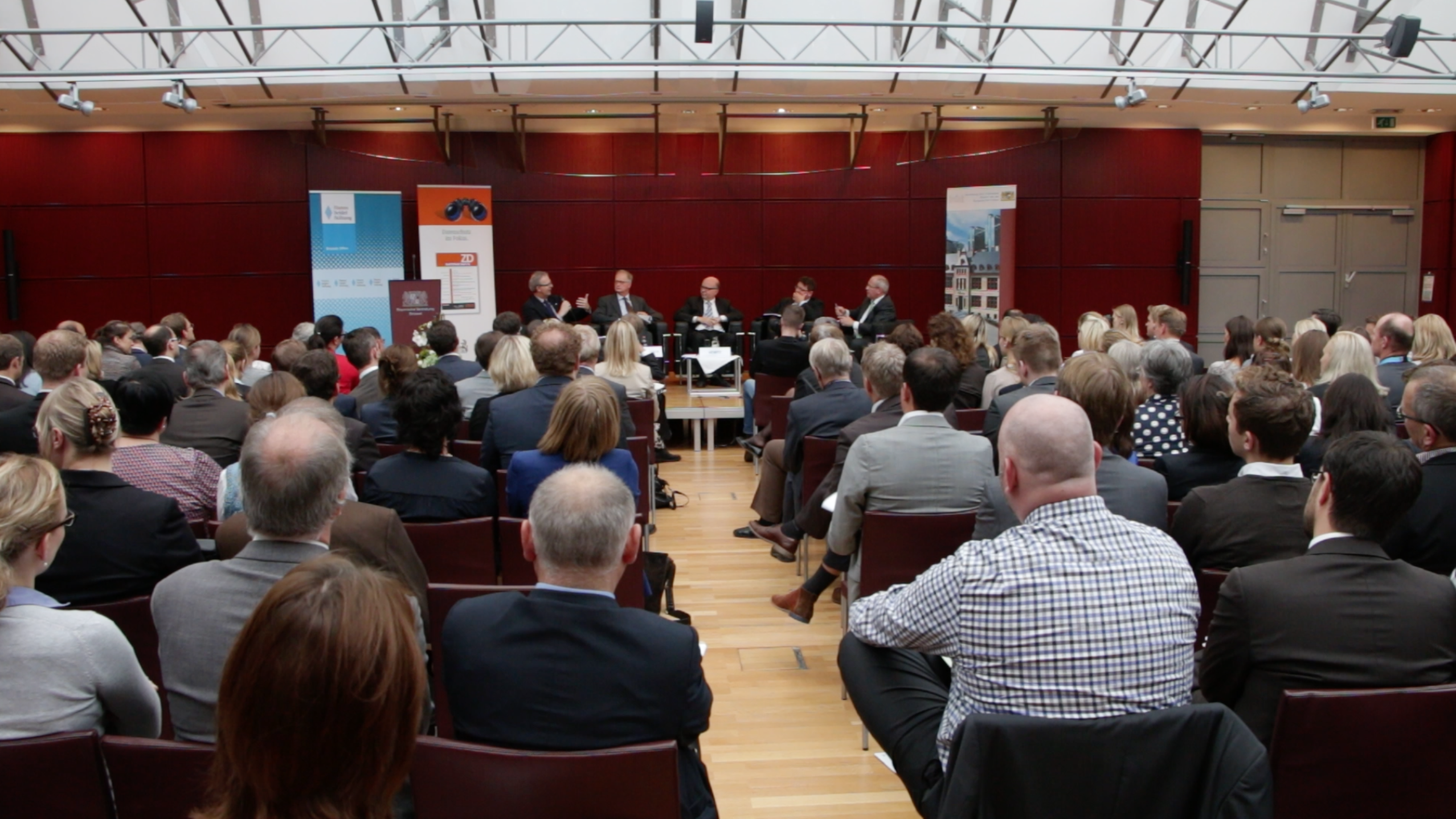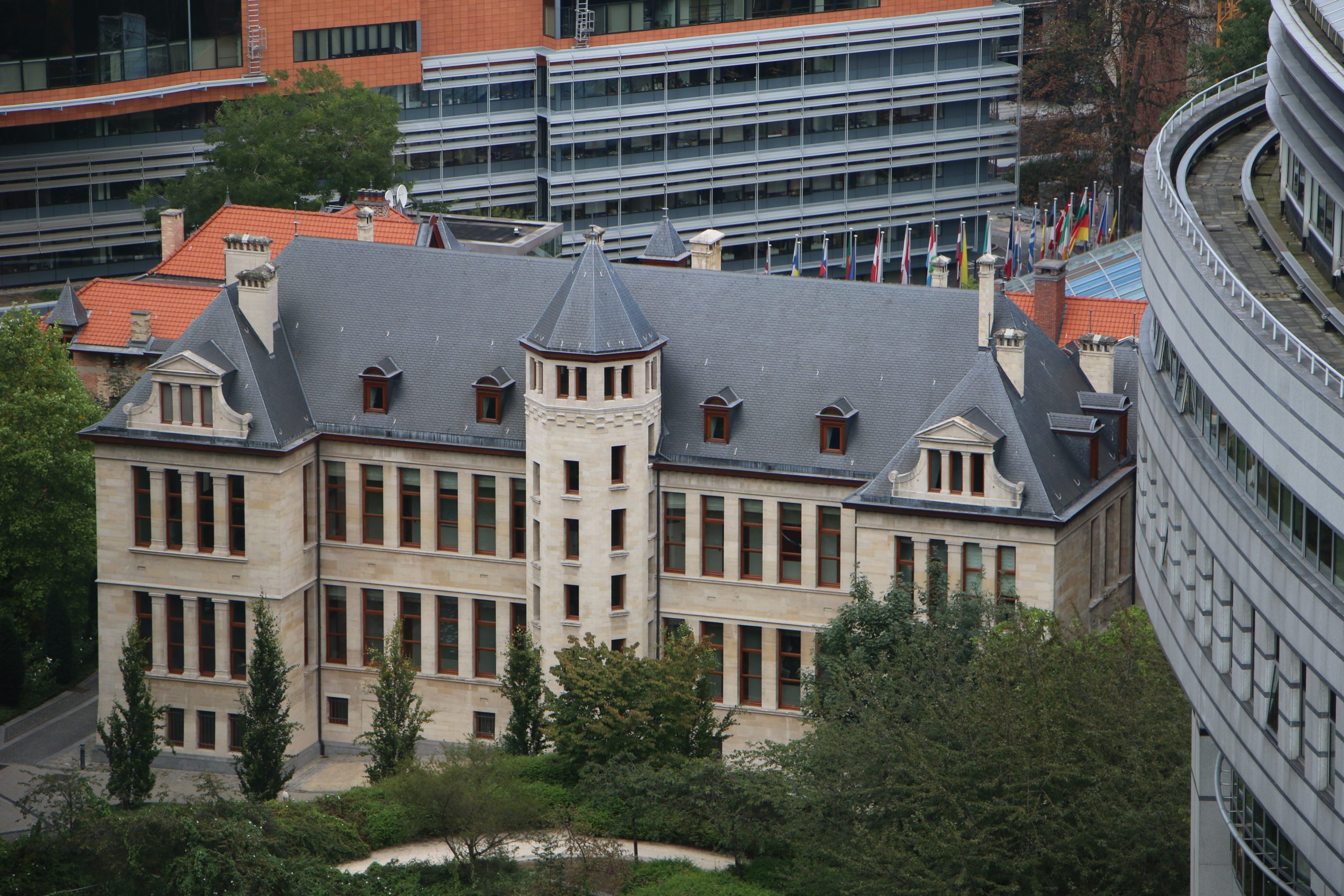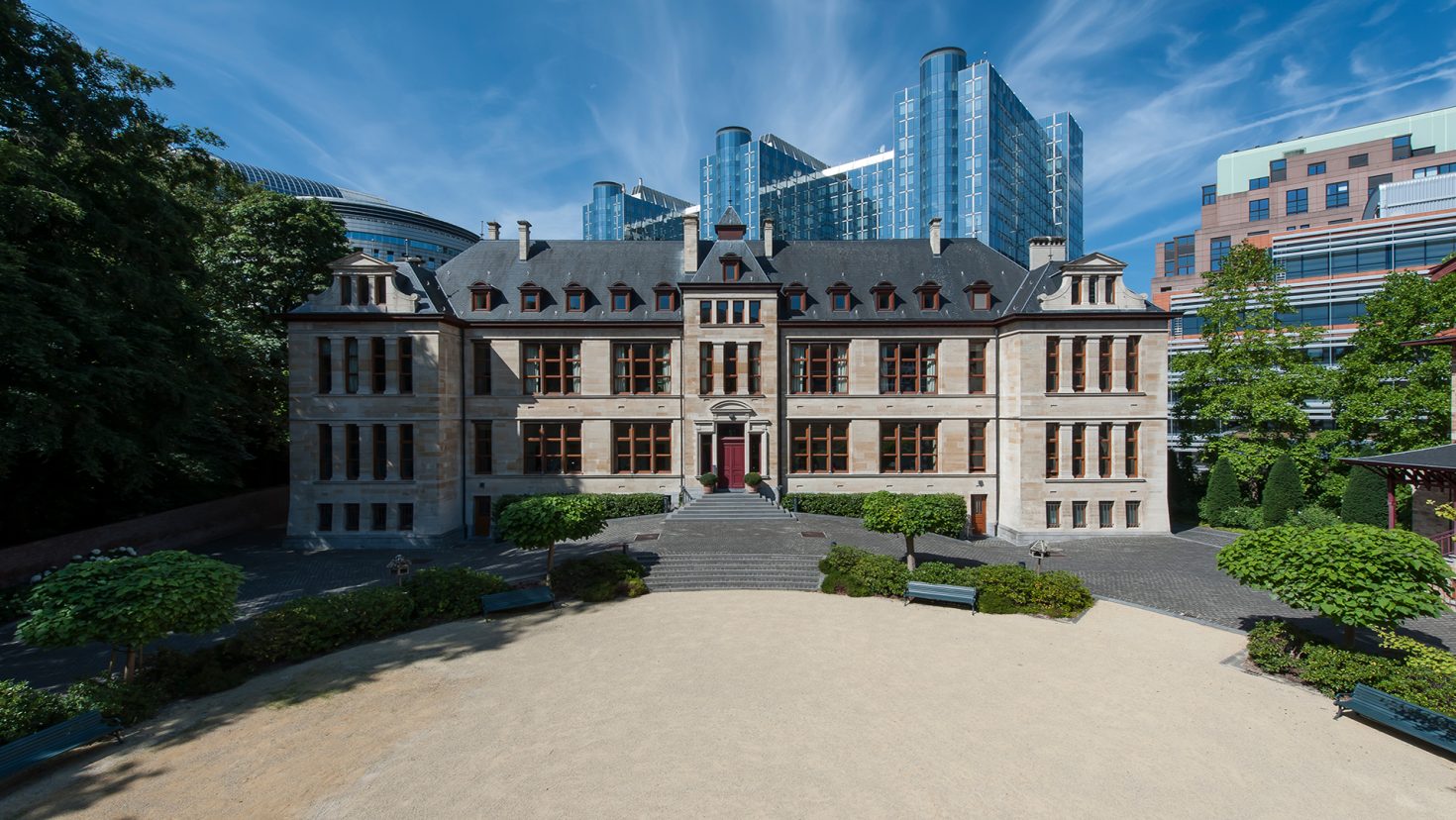
Bavaria in Brussels
The Bavarian Representation in Brussels
The Representation of the Free State of Bavaria to the European Union in Brussels sees itself as an interface between Bavaria and Brussels. As a department of the Bavarian State Chancellery it represents the interests of the Free State of Bavaria in the European Union, provides information on topics of Bavarian concern and represents the Free State in Brussels.
In addition, the representation supports Eric Beißwenger as State Minister for European and International Affairs.
Auf dieser Seite
State Minister Eric Beißwenger
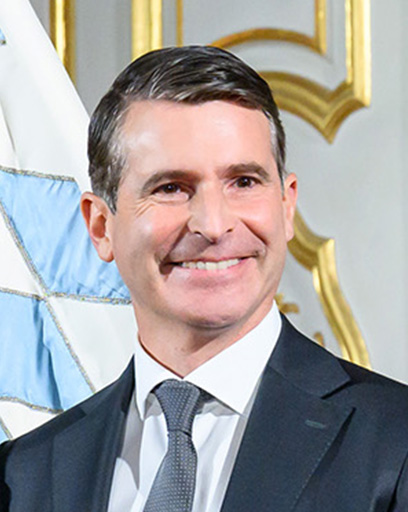
State Minister for European and International Affairs, Eric Beißwenger, is Bavaria’s representative to the European Union. He represents Bavarian interests and explains the political positions of the Free State of Bavaria in meetings with representatives of the press, business and associations.
What we do
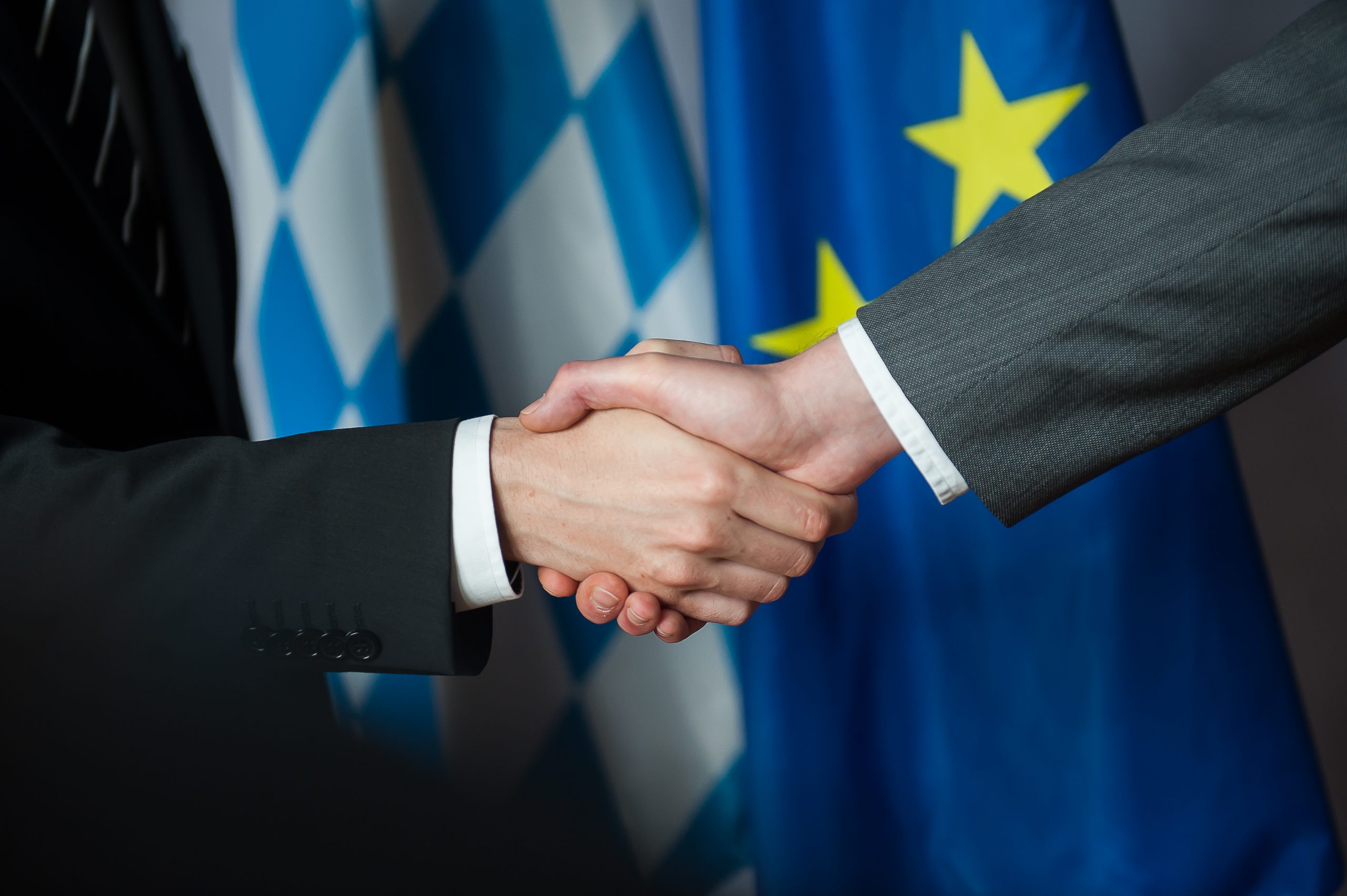
European policy is domestic policy: More than 50 percent of German domestic politics are determined by European law. In some areas, such as economic, agricultural and environmental policy, it is up to 80 percent. Representing Bavarian interests in Brussels and Strasbourg is therefore just as important as representing interests on the federal level.
Interface between Bavaria and Brussels
The Representation of the Free State of Bavaria to the European Union in Brussels supports Eric Beißwenger in fulfilling his duties as State Minister for European and International Affairs. As an interface between Bavaria and Brussels, it informs the State Government, the Bavarian Parliament, the State Administration as well as Bavarian entrepreneurs and citizens at an early stage about important political processes at the European Union. It influences the political decision-making process in the European Union, advises and assists in contacting EU offices and cooperates with other European regional representations based in Brussels. Another important task is the presentation of the Free State in Brussels by means of cultural and political events.
Department of the Bavarian State Chancellery
In organisational terms, the Bavarian Representation in Brussels is a department of the State Chancellery. The representation’s 37 employees create a dense information network to European decision-makers. Diverse working contacts with the Brussels-based institutions, in particular with the European Commission, the European Parliament, the Council of the European Union, the Committee of the Regions as well as with representations of other regions enable an effective representation of Bavaria’s interests.
Forum for regional, cultural and political Events
The Bavarian Representation is a forum for various events. Each year, it organises a number of events with many prominent guests and hosts. The spectrum ranges from regular specialist working groups to conferences and discussions, cultural events and major events. A special feature is the biennial Oktoberfest, which is organised by the Bavarian Representation according to the traditional Bavarian model.
Contact point for European concerns
The Bavarian Representation is open to all visitors with „European matters of interest“: e.g. politicians, citizens, administrations, enterprises and universities. A lot of guests visit the Representation each year and gather insights in its work and current European policy issues.
Visit us
What to expect from a visit to the Bavarian Representation?
In an informative meeting lasting about one hour, a member of staff presents the representation’s work to the groups of visitors and comments on current topics relating to „Bavaria in Europe“.
To whom is our invitation addressed?
To all politically interested people (groups of ten or more) who have always wondered what the Bavarian Representation in Brussels actually does and who want to experience Europe not only in the abstract but in concrete terms.
What to do to make an appointment?
Necessary information:
- short description of the group (association, school class, study group etc.)
- date suggestion
- the number of participants
- special interests
Who to address your inquiry to?
The representation: Historical building and former Institut Pasteur du Brabant
The concept of the new representation for the Free State of Bavaria provided for a careful renovation with new additions to the villa and Marstall building. These additions should fit into the historical ensemble. It was not intended to make major changes to the building stock, but to rehabilitate the ensemble under aspects of monument protection. Thus, parking lots have only been built insofar as they are absolutely necessary for the operation of the representation. By doing so, the representation was able to avoid possible adverse effects (e.g. noise) for the surrounding park.
The ensemble‘s main building was in need of substantial refurbishment and renovation. However, the building structure was still good at the core. In particular, the floors had proved to be sufficiently stable for the intended use. The entire technological infrastructure of the building as well as an extensive part of the attic were renewed and an elevator was installed. The historic sandstone facade was carefully cleaned, replacing the old destroyed windows with new wooden ones. Their structure and character resemble the historic windows. The roof truss was equally rebuilt and the roof provided with a new slate cover referring to its historical appearance. With its representative architectural style, the institute building is ideally suited to the requirements of a regional representation. The Institute is now home to the offices of the Minister-President and the State Minister as well as to several meeting rooms and offices.
There are mostly offices in the villa. The facades were renovated with regard to thermal technology and new windows were used according to the historical model. The roof truss was dismantled and rebuilt. The historic brick masonry facade was carefully cleaned and minor defects were repaired. Since the villa does not offer enough spacial capacities, an extension was added. It is reduced in appearance and its eaves height do not exceed the old villa‘s eaves.
The old Marstall building is now used as an event area. The foyer and the catering kitchen for the large hall are situated here. Its facade was also carefully cleaned, defects repaired and the windows rebuilt using old materials according to the historical appearance. All the details relevant to the appearance, such as the cornices, the door and the window constructions, were designed to fit the historical models. The outbuilding to the Marstall was in such a bad condition that a renovation no longer made sense. This was the only part of the building in the entire ensemble that needed to be demolished. The outbuilding was replaced by the large event hall, which now connects with the Marstall building. In the choice of materials, this new building was adapted to the historical building materials. Although its structural outer wall is made of reinforced concrete, it has been provided with a facing made of exposed brickwork. The eaves height of the new building remained below the one of the historic Marstall building. Also the apex of the glass roof ends right below the roof ridge of the Marstall building.
The Institute grounds should be preserved and redeveloped as a part of Parc Léopold. The reason why the Representation is not surrounded by a high wall and demarcated from it today. Only the unavoidable security precautions were put in place, but these have in no way had a negative impact on the appearance of the overall complex. The visual connection between the Institut Pasteur du Brabant and Parc Léopold was preserved and even significantly enhanced with the landscaping and new plantings. Today, visitors enter the Bavarian Representation via Rue Wiertz.
Contact us
Representation of the Free State of Bavaria to the European Union
Rue Wiertz 77
1000 Brussels
Belgium
Tel.: + 32 (0) 2 – 23 74 811
Fax: + 32 (0) 2 – 23 74 943
Email: bayern.vertretung@stk.bayern.de
Contact us:
Organisational Chart
Detailed route directions:
Please find below some advice on your journey via plane, train, car or bus and useful information on the Low Emission Zone Brussels.
Advice on your journey
- There is no parking space on the grounds of the representation.
- The south-western part of Rue Wiertz is closed to car traffic for safety reasons.
- Buses are not allowed to use the inner-city tunnels in Brussels. There are separate directions for bus drivers.
- In navigation systems, the street names are stored in French Rue Wiertz or Dutch Wiertzstraat. Some navigation systems and city maps still list this part of the street as Rue de Remorqueur or Remorqueurstraat.
- Visitors should ring the bell at the gate of Rue Wiertz 77.
In Brussels a low emission zone (LEZ) was introduced in January 2018. The license plates of all vehicles entering the LEZ are automatically recorded by cameras. The Brussels environmental zone covers the entire Brussels region, with the exception of the Ring motorway. Vehicles with a non-Belgian registration number must be registered free of charge. Drivers of unregistered vehicles must be prepared for penalty payments.
Take the Airport Express (bus line 12) or the airport train (Diabolo) from Brussels Airport-Zaventem to Gare du Luxembourg (Brussels). From the bus stop you cannot miss the huge buildings of the European Parliament. The same applies if you travel by train and leave the station via one of the two side exits.Beneath one of the buildings of the European Parliament there are passages leading directly to Rue Wiertz. Turn left onto Rue Wiertz.The Bavarian Representation is located – surrounded by trees – on the right side of the road. Please ring the doorbell (77 rue Wiertz).
Get off at Gare du Midi (Zuidstation). From there, take the metro line 2 or 6 direction Simonis (Elisabeth) to the stop named Trône, exit Rue du Luxembourg. Follow Rue du Luxembourg. At the end of the street you can already see the buildings of the European Parliament.
Under one of these buildings is a passageway that leads directly to Rue Wiertz. Turn left onto Rue Wiertz. The Bavarian Representation is located – surrounded by trees – on the right side of the road. Please ring the doorbell (77 rue Wiertz).
Via Aachen:
On the A44 / E40 motorway always head to Brussels city centre (not Ring!), following the signs to the EU institutions. You will then automatically reach Avenue de Cortenbergh through a tunnel, which ends in a roundabout, Rond Point Schuman.At the roundabout, take the second right (Rue de la Loi). Take the first left (Rue de Trèves). Turn left again at the next traffic lights onto Rue Belliard. Take the next right (entrance to the European Parliament underground parking).
A left-hand bend will take you automatically to Rue Wiertz. The Bavarian Representation is right in front of you. Please ring the doorbell (77 rue Wiertz). Parking is not available onsite!
If you are using a navigation system, please note that the street name can be saved in French (Rue Wiertz) or Dutch (Wiertzstraat). Some navigation systems and city maps also use this part of the road as Rue de Remorqueur / Remorqueurstraat. Please also note that the south-western part of Rue Wiertz is closed for security reasons.
Via Luxembourg:
Take the E411 motorway from Luxembourg via Namur, take the exit Brussels Ring. After a tunnel (on your left), take the exit „Brussels“ after 7 km. Follow the motorway E40, direction Centre / EU-Institutions, which finally leads you through a tunnel onto Avenue de Cortenbergh. Follow this road until you reach a roundabout, the Rond Point Schuman.
At the roundabout, take the second right (Rue de la Loi). Take the first left (Rue de Trèves). Turn left again at the next traffic lights onto Rue Belliard. Take the next right (entrance to the European Parliament underground parking).
A left-hand bend will take you automatically to Rue Wiertz. The Bavarian Representation is right in front of you. Please ring the doorbell (77 rue Wiertz). Parking is not available onsite!
If you are using a navigation system, please note that the street name can be saved in French (Rue Wiertz) or Dutch (Wiertzstraat). Some navigation systems and city maps also lead this part of the street as Rue de Remorqueur / Remorqueurstraat. Please also note that the south-western part of Rue Wiertz is closed for security reasons.
Buses are not allowed in Brussels‘ inner city tunnels, so please see separate directions!
Via Aachen:
Take the A44/E40 motorway to exit 19 Evere / Woluwe. There turn right in the direction of Evere. At the next traffic lights, turn left onto Chaussée de Louvain. Follow this road to Place Madou (until then you will pass the roundabout Meiser and Place St.-Josse). At Place Madou, turn left onto Avenue des Arts, then take the second left onto Rue Belliard. Get into the right lane and turn right into Rue d’Ardenne on the 7th street (shortly after crossing a railway bridge).
Attention! When travelling with a double-decker bus, pay attention to height restrictions of the bridge! Turn left in front of the entrance to an underground parking. The entrance to the Bavarian Representation is directly in front of you.
Please get off the bus here and ring the bell at the gate (77 rue Wiertz). Parking is not available onsite! The nearest parking spots for buses are located in Rue Montoyer, Avenue Nerviens, Avenue de la Renaissance and inside Parc Cinquantenaire. If you are using a navigation system, please note that the street name can be saved in French (Rue Wiertz) or Dutch (Wiertzstraat). Some navigation systems and city maps also use this part of the road as Rue de Remorqueur / Remorqueurstraat.
Please also note that the south-western part of Rue Wiertz is closed for security reasons.
Via Luxembourg:
Take the E411 motorway from Luxembourg via Namur, take the exit Brussels Ring. After a tunnel (on your left), take the exit „Brussels“ after 7 km and head onto the E40 motorway. Take exit 19 Evere / Woluwe. There turn right in the direction of Evere. At the next traffic lights, turn left onto Chaussée de Louvain. Follow this road to Place Madou (until then you will pass the roundabout Meiser and Place St.-Josse). At Place Madou, turn left onto Avenue des Arts, then take the second left onto Rue Belliard. Get into the right lane and turn right into Rue d’Ardenne on the 7th street (shortly after crossing a railway bridge).
Attention! When travelling with a double-decker bus, pay attention to height restrictions of the bridge! Turn left in front of the entrance to an underground parking. The entrance to the Bavarian Representation is directly in front of you.
Please get off the bus here and ring the bell at the gate (77 rue Wiertz). Parking is not available onsite! The nearest parking spots for buses are located in Rue Montoyer, Avenue Nerviens, Avenue de la Renaissance and inside Parc Cinquantenaire. If you are using a navigation system, please note that the street name can be saved in French (Rue Wiertz) or Dutch (Wiertzstraat). Some navigation systems and city maps also use this part of the road as Rue de Remorqueur / Remorqueurstraat.
Please also note that the south-western part of Rue Wiertz is closed for security reasons.



